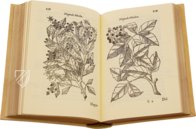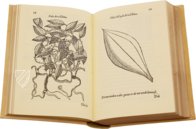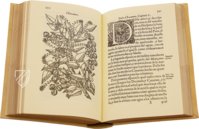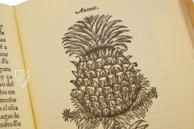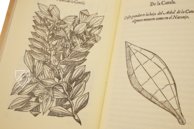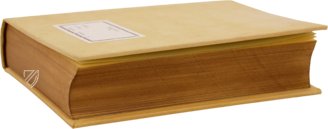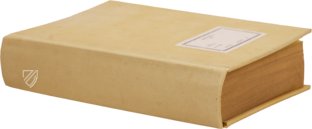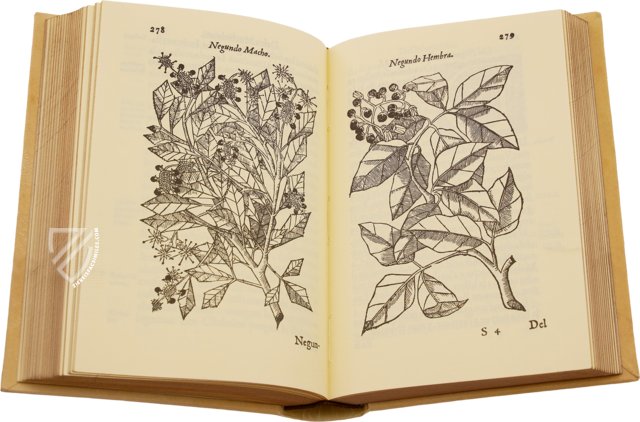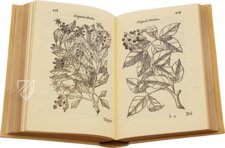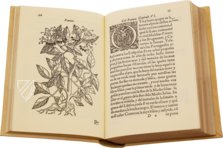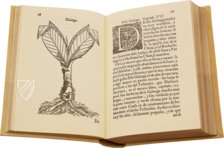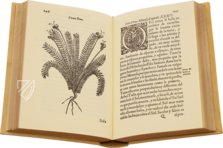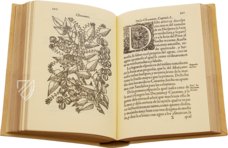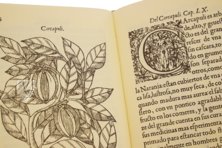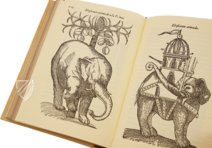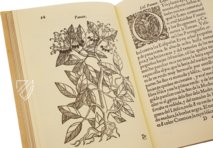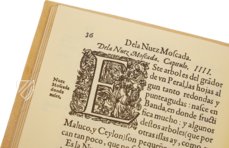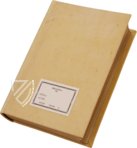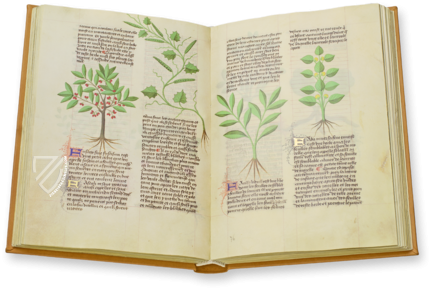Tractado de las Drogas, y Medicinas de las Indias Orientales…
(under 1,000€)
This historic text introduced Europe to the most important medicinal plants from Asia. The gorgeous and informative work was so popular that it appeared in numerous editions and multiple translations over the coming years. Partly based on previous authors such as Garcia de Orta, it represents the culmination of the travels and practical experience of the Portuguese doctor and natural historian Cristóvão da Costa or Cristóbal Acosta, a pioneer of Oriental botany and pharmacology in Europe. First published in 1578, the work has appeared in various editions and was translated into Italian in 1585 and later partially in Latin. It is adorned by 23 woodcuts and is appended by a treatise on the Asian elephant and is thus probably the first of its kind in Europe as well as being one of the first works to record the Basque language.
Tractado de las Drogas, y Medicinas de las Indias Orientales…
This splendid work was authored by Cristóvão da Costa (ca. 1525 – ca. 1594), also written as Cristóbal Acosta, and reflects the extensive travels undertaken by the Portuguese doctor and natural historian in the East as a soldier, India and Indonesia in particular. He claims that he was inspired by his desire to find "in several regions and provinces learned and curious men from whom I could daily learn something new; and to see the diversity of plants God has created for human health". His findings, titled the Treatise of the Drugs and Medicines of the East Indies in English, were published on the 16th of July 1578 by Martín de Victoria, a printer in Burgos. It also discusses the use of spices like cinnamon, pepper, clove, nutmeg, tamarind, rhubarb, ginger, etc.
Although Europeans had imported these spices for a long time, either via the Silk Road or by sea, this was the first time that depictions of the plants that produced them were made available to Europeans. Additionally, it contains the Tractado del elefante, probably the first such work with a detailed study of the world’s largest land animals to be published in Europe. All of this is adorned with gorgeous engravings: 49 full-page illustrations and 72 initials.
Codicology
- Alternative Titles
- Geschichte über die Medizin des östlichen Indiens
Tractado de las Drogas, y Medicinas de las Indias Orientales, con sus Plantas Debuxadas al Vivo por Cristobal de Acosta, Medico y Cirujano que las Vio Ocularmente. Tractado del Elephante y de sus Calidades. - Size / Format
- 510 pages / 19.8 × 13.5 cm
- Origin
- Spain
- Date
- July 16, 1578
- Epochs
- Style
- Language
- Illustrations
- 49 full-page xylographs and 72 decorated initials
- Content
- Treatise on the most important Asian plants and spices used in Europe and their medicinal applications; treatise on elephants
- Artist / School
- Cristóbal de Acosta (author)
Martín de Victoria (printer)
Tractado de las Drogas, y Medicinas de las Indias Orientales…
Nutmeg
Native to the Banda Islands of Indonesia, nutmeg was one of the world’s most profitable commodities in the 16th century when this text was written. The Portuguese conquered Malacca in 1511 and gained direct access to the highly coveted spice in 1512. A nutmeg seed shell with its characteristic grooves is depicted here in detail. This is left out in the sun for 6-8 weeks to dry and is ready once the kernels rattle when shaken. The shell is then cracked open and the kernels are ground into a powder.
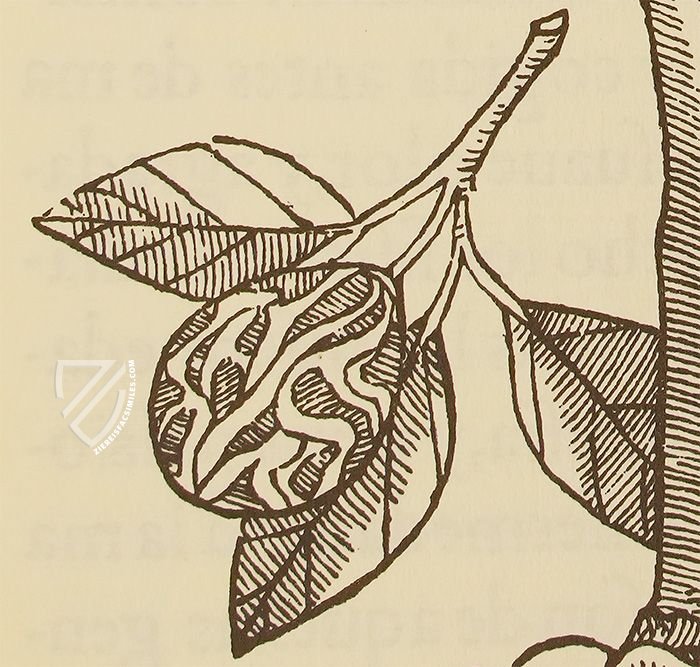
Tractado de las Drogas, y Medicinas de las Indias Orientales…
Elephant Standing under a Palm Tree
This image perfectly sums up the European fascination with the exotic during the Age of Exploration: the elephant is an impossibly large and powerful beast whose existence was difficult for many Europeans to believe, and the palm tree is immediately associated with foreign tropical climates and tranquil islands in turquoise-colored waters.
No distinction is made for the type of elephant depicted, be it the smaller Asian or larger African variety, but it is missing a leg nonetheless, perhaps it is obscured by the trunk of the tree. The specific variety of palm depicted is a coconut tree, whose name comes from the old Portuguese word coco, meaning “head” or “skull” due to the indentations on the shell that resemble facial features.
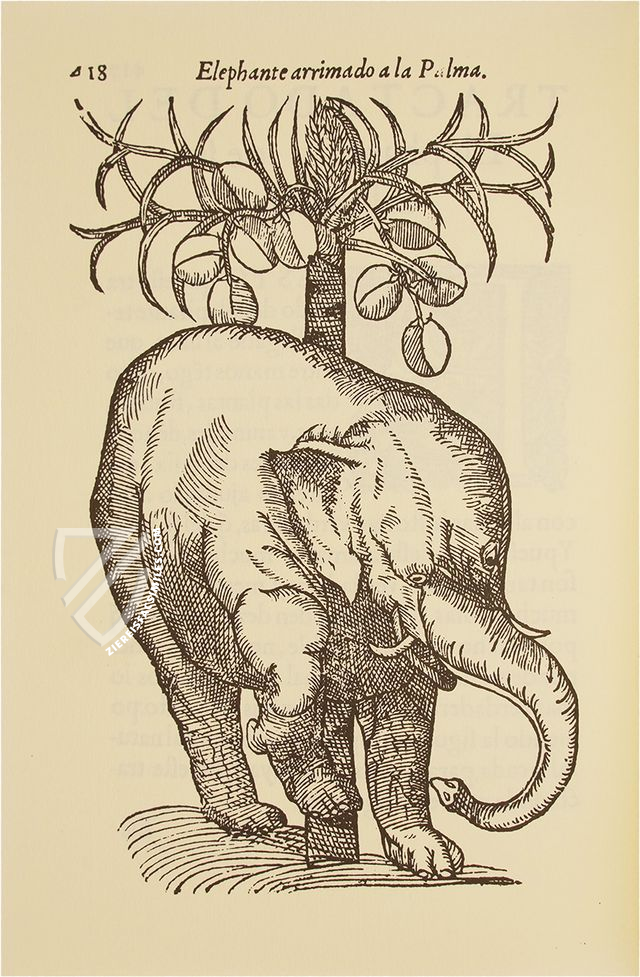
#1 Tractado de las Drogas, y Medicinas de las Indias Orientales, con sus Plantas Debuxadas al Vivo por Cristobal de Acosta, Medico y Cirujano que las Vio Ocularmente. Tractado del Elephante y de sus Calidades.
Language: Spanish
(under 1,000€)
- Treatises / Secular Books
- Apocalypses / Beatus
- Astronomy / Astrology
- Bestiaries
- Bibles / Gospels
- Chronicles / History / Law
- Geography / Maps
- Saints' Lives
- Islam / Oriental
- Judaism / Hebrew
- Single Leaf Collections
- Leonardo da Vinci
- Literature / Poetry
- Liturgical Manuscripts
- Medicine / Botany / Alchemy
- Music
- Mythology / Prophecies
- Psalters
- Other Religious Books
- Games / Hunting
- Private Devotion Books
- Other Genres
- Afghanistan
- Armenia
- Austria
- Belgium
- Colombia
- Croatia
- Cyprus
- Czech Republic
- Denmark
- Egypt
- Ethiopia
- France
- Germany
- Greece
- Hungary
- India
- Iran
- Iraq
- Israel
- Italy
- Japan
- Lebanon
- Luxembourg
- Mexico
- Morocco
- Netherlands
- Palestine
- Peru
- Poland
- Portugal
- Russia
- Serbia
- Spain
- Sri Lanka
- Sweden
- Switzerland
- Syria
- Turkey
- Ukraine
- United Kingdom
- United States
- Uzbekistan
- Aboca Museum
- Ajuntament de Valencia
- Akademie Verlag
- Akademische Druck- u. Verlagsanstalt (ADEVA)
- Aldo Ausilio Editore - Bottega d’Erasmo
- Alecto Historical Editions
- Alkuin Verlag
- Almqvist & Wiksell
- Amilcare Pizzi
- Andreas & Andreas Verlagsbuchhandlung
- Archa 90
- Archiv Verlag
- Archivi Edizioni
- Arnold Verlag
- ARS
- Ars Magna
- ArtCodex
- AyN Ediciones
- Azimuth Editions
- Badenia Verlag
- Bärenreiter-Verlag
- Belser Verlag
- Belser Verlag / WK Wertkontor
- Benziger Verlag
- Bernardinum Wydawnictwo
- BiblioGemma
- Biblioteca Apostolica Vaticana (Vaticanstadt, Vaticanstadt)
- Bibliotheca Palatina Faksimile Verlag
- Bibliotheca Rara
- Boydell & Brewer
- Bramante Edizioni
- Bredius Genootschap
- Brepols Publishers
- British Library
- C. Weckesser
- Caixa Catalunya
- Canesi
- CAPSA, Ars Scriptoria
- Caratzas Brothers, Publishers
- Carus Verlag
- Casamassima Libri
- Chavane Verlag
- Christian Brandstätter Verlag
- Circulo Cientifico
- Club Bibliófilo Versol
- Club du Livre
- CM Editores
- Collegium Graphicum
- Collezione Apocrifa Da Vinci
- Comissão Nacional para as Comemorações dos Descobrimentos Portugueses
- Coron Verlag
- Corvina
- CTHS
- D. S. Brewer
- Damon
- De Agostini/UTET
- De Nederlandsche Boekhandel
- De Schutter
- Deuschle & Stemmle
- Deutscher Verlag für Kunstwissenschaft
- DIAMM
- Droz
- E. Schreiber Graphische Kunstanstalten
- Ediciones Boreal
- Ediciones Grial
- Ediclube
- Edições Inapa
- Edilan
- Editalia
- Edition Deuschle
- Edition Georg Popp
- Edition Leipzig
- Edition Libri Illustri
- Editiones Reales Sitios S. L.
- Éditions de l'Oiseau Lyre
- Editions Medicina Rara
- Editorial Casariego
- Editorial Mintzoa
- Editrice Antenore
- Editrice Velar
- Edizioni Edison
- Egeria, S.L.
- Eikon Editores
- Electa
- Emery Walker Limited
- Enciclopèdia Catalana
- Eos-Verlag
- Ephesus Publishing
- Ernst Battenberg
- Eugrammia Press
- Extraordinary Editions
- Fackelverlag
- Facsimila Art & Edition
- Facsimile Editions Ltd.
- Facsimilia Art & Edition Ebert KG
- Faksimile Verlag
- Feuermann Verlag
- Folger Shakespeare Library
- Franco Cosimo Panini Editore
- Friedrich Wittig Verlag
- Fundación Hullera Vasco-Leonesa
- G. Braziller
- Gabriele Mazzotta Editore
- Gebr. Mann Verlag
- Gesellschaft für graphische Industrie
- Getty Research Institute
- Giovanni Domenico de Rossi
- Giunti Editore
- Graffiti
- Grafica European Center of Fine Arts
- Guido Pressler
- Guillermo Blazquez
- Gustav Kiepenheuer
- H. N. Abrams
- Harrassowitz
- Helikon
- Hendrickson Publishers
- Henning Oppermann
- Herder Verlag
- Hes & De Graaf Publishers
- Hoepli
- Holbein-Verlag
- Hortus Deliciarum
- Houghton Library
- Hugo Schmidt Verlag
- Idion Verlag
- Il Bulino, edizioni d'arte
- ILte
- Imago
- Insel Verlag
- Instituto Nacional de Antropología e Historia
- Istituto dell'Enciclopedia Italiana - Treccani
- Istituto Ellenico di Studi Bizantini e Postbizantini
- Istituto Geografico De Agostini
- Istituto Poligrafico e Zecca dello Stato
- Italarte Art Establishments
- J. Thorbecke
- Jan Thorbecke Verlag
- Johnson Reprint Corporation
- Josef Stocker
- Josef Stocker-Schmid
- Jugoslavija
- Karl W. Hiersemann
- Kasper Straube
- Kaydeda Ediciones
- Kindler Verlag / Coron Verlag
- Kodansha International Ltd.
- Konrad Kölbl Verlag
- Kurt Wolff Verlag
- La Liberia dello Stato
- La Linea Editrice
- La Meta Editore
- Lambert Schneider
- Landeskreditbank Baden-Württemberg
- Leo S. Olschki
- Les Incunables
- Library of Congress
- Libreria Musicale Italiana
- Lichtdruck
- Lito Immagine Editore
- Lumen Artis
- Lund Humphries
- M. Moleiro Editor
- Maison des Sciences de l'homme et de la société de Poitiers
- Manuscriptum
- Martinus Nijhoff
- Maruzen-Yushodo Co. Ltd.
- MASA
- McGraw-Hill
- Militos
- Millennium Liber
- Müller & Schindler
- Nahar and Steimatzky
- National Library of Wales
- Neri Pozza
- Nova Charta
- Oceanum Verlag
- Odeon
- Orbis Mediaevalis
- Orbis Pictus
- Österreichische Staatsdruckerei
- Oxford University Press
- Pageant Books
- Parzellers Buchverlag
- Patrimonio Ediciones
- Pattloch Verlag
- PIAF
- Pieper Verlag
- Plon-Nourrit et cie
- Prestel Verlag
- Princeton University Press
- Prisma Verlag
- Priuli & Verlucca, editori
- Pro Sport Verlag
- Propyläen Verlag
- Pytheas Books
- Quaternio Verlag Luzern
- Reales Sitios
- Recht-Verlag
- Reichert Verlag
- Reichsdruckerei
- Riehn & Reusch
- Roberto Vattori Editore
- Rosenkilde and Bagger
- Roxburghe Club
- Salerno Editrice
- Sarajevo Svjetlost
- Schöck ArtPrint Kft.
- Scolar Press
- Scrinium
- Scripta Maneant
- Scriptorium
- Siloé, arte y bibliofilia
- SISMEL - Edizioni del Galluzzo
- Sociedad Mexicana de Antropología
- Société des Bibliophiles & Iconophiles de Belgique
- Soncin Publishing
- Sorli Ediciones
- Stainer and Bell
- Studer
- Styria Verlag
- Sumptibus Pragopress
- Szegedi Tudomànyegyetem
- Taberna Libraria
- Tarshish Books
- Taschen
- Tempus Libri
- Testimonio Compañía Editorial
- Thames and Hudson
- The Clear Vue Publishing Partnership Limited
- The Facsimile Codex
- The Folio Society
- The Marquess of Normanby
- The Richard III and Yorkist History Trust
- Tip.Le.Co
- TouchArt
- TREC Publishing House
- TRI Publishing Co.
- Trident Editore
- Typis Regiae Officinae Polygraphicae
- Union Verlag Berlin
- Universidad de Granada
- University of California Press
- University of Chicago Press
- Urs Graf
- Vallecchi
- Van Wijnen
- VCH, Acta Humaniora
- VDI Verlag
- VEB Deutscher Verlag für Musik
- Verlag Anton Pustet / Andreas Verlag
- Verlag Bibliophile Drucke Josef Stocker
- Verlag der Münchner Drucke
- Verlag für Regionalgeschichte
- Verlag Styria
- Vicent Garcia Editores
- W. Turnowsky
- Waanders Printers
- Wiener Mechitharisten-Congregation (Wien, Österreich)
- Wissenschaftliche Buchgesellschaft
- Wydawnictwo Dolnoslaskie
- Xuntanza Editorial
- Zakład Narodowy
- Zollikofer AG




